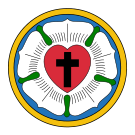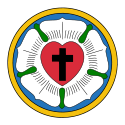- Common table prayer
-
The Common Table Prayer is arguably the best known mealtime prayer among North American Lutherans. Several other variations also exist.
Contents
History
The Common Table Prayer was first published in the year 1753 in a Moravian hymnal, Etwas vom Liede Mosis, des Knechts Gottes, und dem Liede des Lammes, das ist: Alt- und neuer Brüder-Gesang. The title was Tisch-Gebetgen, or Table Prayer. There are possibilities that the prayer is from an older text with Lutheran origins. In the Moravian hymnal the prayer is not placed in the "Old Moravian Hymns" chapter or in the eighteenth-century Moravian hymns" chapter. Instead it is placed in the chapter titled "evangelical hymns from the seventeenth century". Dietrich Meyer put as author of the prayer "author unknown". In the Evangelisch-Lutherisher Gebets-Schatz or Evangelical-Lutheran Prayer Treasures, the prayer is attributed to Martin Luther, but this is highly speculated.
Text and Variations
Original German:
- Komm, Herr Jesu; sei du unser Gast;
- und segne, was du uns bescheret hast.
English:
- Come, Lord Jesus, be our Guest;
- And bless what you have bestowed.
or alternatively, a Moravian translation,
- Come, Lord, Jesus, our Guest to be
- And bless these gifts bestowed by Thee.
There are several variations common today for the second line. In English there are other second lines such as "Let these gifts to us be blessed," "Let Thy gifts to us be blessed," "Let these Thy gifts to us be blessed," "Let these foods to us be blessed," "And let this food by Thee be blessed, "let these gifts to us be blessed and may our souls by thee be fed ever on the living bread," and "and bless what you have bestowed to us out of mercy". Also in German there are several other versions such as "und segne, was du uns bescheret hast," and "und segne, was du uns aus Gnaden bescheret hast". A second "verse" may also be added: "Blessed be God who is our bread; may all the world be clothed and fed." Moravians often add "Bless our loved ones everywhere and keep them in Thy loving care."
Sometimes the verse of Psalm 136:1 is added at the end. "O give thanks unto the Lord, for He is good: For His mercy endureth forever."
See also
External links
- LCMS-Who wrote the common table prayer and where did it come from?
- WELS-Prayer matters, the Common Table Prayer
Lutheranism Six Chief Parts of
Luther's Small CatechismThe Ten Commandments · Apostle's Creed · Lord's Prayer · Sacrament of Holy Baptism · Confession · Sacrament of the Eucharist
Chief Articles of Faith
in the
Augsburg ConfessionI. God · II. Original Sin · III. The Son of God · IV. Justification By Faith · V. The Office of Preaching · VI. Of The New Obedience · VII. Of The Church · VIII. What the Church Is · IX. Of Baptism · X. Of the Lord's Supper · XI. Of Confession · XII. Of Repentance · XIII. Of the Use of the Sacraments · XIV. · XV. Ecclesiastical Usages · XVI. Of Civil Affairs · XVII. Of Christ's Return to Judgment · XVIII. Of Free Will · XIX. Of the Cause of Sin · XX. Of Good Works · XXI. Of the Worship of the SaintsPractices Divine Service · Confirmation · Common table prayer · Sign of The Cross · Matins · Vespers · Easter Vigil · Liturgical Calendar · Ecumenical Miracle RosaryMovements Gnesio-Lutherans · Crypto-Calvinism · Philippists · Sacramentarians · Ubiquitarians · Lutheran Orthodoxy · Pietism · Laestadianism · Old Lutherans · Neo-Lutheranism · High Church Lutheranism · Evangelical Catholicism · Confessional LutheransLutheranism portal Categories:- Christian prayer
- Lutheran liturgy and worship
Wikimedia Foundation. 2010.

